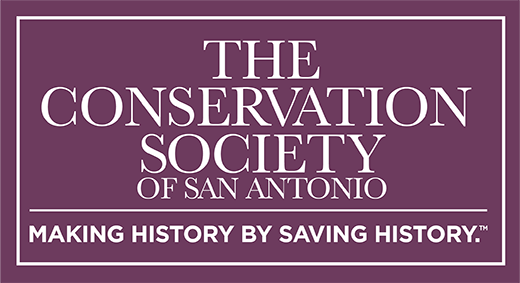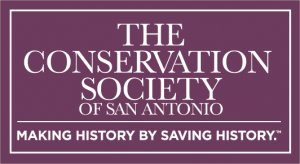Contributing to the Cause
1996
Saving San Antonio: The Precarious Preservation of a Heritage, by Lewis F. Fisher, published documenting the official history of the Conservation Society.
Conservation Society files a friend of the court brief supporting the City of Boerne in its Supreme Court case against Archbishop Patrick Flores to preserve the historic Saint Peter the Apostle Catholic Church.
1997
 Paula D. Piper elected president.
Paula D. Piper elected president.
Conservation Society completes a survey of historic SAISD schools in conjunction with the district’s $483 million bond issue to update and renovate school buildings.
1998
Project ReNew rehabilitation work begins with a demonstration project to revitalize an inner-city neighborhood south of Five Points.
Conservation Society commissions a conceptual/reuse plan for development of the endangered Ellis Alley area on the East Side.
1999
Conservation Society develops design guidelines for Houston Street revitalization in conjunction with developer Federal Realty Investment Trust.
The city receives a gift of $67,145 from the Conservation Society for the construction of iron fences around the city cemeteries on East Commerce Street.
 Loyce Ince elected president.
Loyce Ince elected president.
Conservation Society donates $21,000 towards the restoration of the historic San Juan Acequia to maintain rights to the water that historically irrigated Mission San Juan Capistrano and its adjacent farmlands.
2000
A Programmatic Agreement with Kelly Air Force Base, co-signed by the Conservation Society, leads to the listing of the base’s historic Bungalow Colony on the National Register of Historic Places.
Conservation Society receives an Institute Honors for Collaborative Achievement Award from the American Institute of Architects, recognizing the Society for over 75 years of beneficial influence on the architectural profession.
Demolition of the 1926 dormitory Mary Catherine Hall at Assumption Seminary results in city commitment to a historic structures survey within the historic 36-mile boundary of San Antonio. Conservation Society contributes $50,000 towards project.
2001
Hays Street Bridge linking downtown to city’s East Side from 1910 to 1982 designated a Texas Historic Civil Engineering Landmark. Conservation Society later contributes $50,000 towards reuse of the bridge as part of a hike and bike trail.
 Jill Harrison Souter elected president.
Jill Harrison Souter elected president.
President George W. and First Lady Laura Bush attend the dedication of the restored gristmill at the San José Granary.
Conservation Society opposition fails to stop Museo Americano from obtaining approval to demolish the original arches on the 1920’s Centro de Artes Building, a city-owned landmark in Market Square.
“Conservation Conversations”, a Conservation Society sponsored speakers’ series on historic preservation and urban development, is launched. Featured speakers include: authors Roberta Brandes Gratz and Dwight Young, plus Charleston mayor Joseph P. Riley.
2002
Despite a $50,000 challenge grant offered by the Society towards the purchase of La Gloria, a unique 1928 West Side gas station with a rooftop dance floor, the building is demolished to make room for a commercial diesel mechanic shop.
Hidalgo Foundation receives $300,000 for the restoration of the Bexar County Courthouse from the Conservation Society.
The Society Journal receives the Award of Excellence at the International Association of Business Communicators annual Bronze Quill Awards.
2003
The Society urges the City and the Director of the Texas Department of Transportation to enforce rules against illegal off-premise billboard signage along the U.S. Highway 281 corridor.
The Society joins other interested parties in lobbying the City to restore the name of Durango Boulevard, resulting in street signs with the original street name coupled with a designation honoring Judge H.F. Garcia.
Historic John Palmer Leeper house relocated from the grounds of the McNay Art Museum to Mitchell Lake for use as a Wildlife Refuge Center through the efforts of the Conservation Society, the City, the San Antonio Water System, and the Mitchell Lake Wetlands Society.
 Loretta Huddleston elected president.
Loretta Huddleston elected president.
The Society works with the City to revise the design for an addition to the Stinson Field terminal so that the original Art Deco façade will remain visible from the street.
2004
Historical Society of Leon Valley receives a $6,000 grant from the Conservation Society for further stabilization of the Huebner-Onion House, a former stagecoach stop.
The Society urges the city to enforce demolition by neglect provisions for the Toudouze Buildings at 711 and 721 West Commerce, resulting in a covenant on the property requiring the owner to construct a “reasonable facsimile” of the demolished buildings on the site.
The Society awards $10,000 to the Witte Museum for the preservation of the Hertzberg Circus Collection.
 Barbara Johnson elected president.
Barbara Johnson elected president.
Conservation Society files an unsuccessful lawsuit against Board of Adjustment for allowing the move of a portable classroom building into the Government Hill Historic District as housing.
2005
“Trails to Treasure” benefit chaired by the Society’s second Vice President helps to raise funds for restoration of the Hays Street Bridge.
The Society coordinates the stabilization of the adobe Bergara–Le Compte House on Guadalupe Street using funds provided by the City and the Texas Historical Commission.
The City makes successful legal claim to Miraflores Park, the historic retreat created by Dr. Aureliano Urrutia, with help from a land survey paid for by the Conservation Society.
In keeping with its position against changing the historic names of streets, the Society protests changing Laredo Street to Goodwill Way.
2006
The Society supports limiting formula restaurants on the River Walk, as well as a ban on commercial vendors, in order to preserve the unique character of one of the state’s leading tourist attractions.
The Society opposes any permanent closing of the streets on Main Plaza as proposed by the City in its redesign, citing the disruption of the circulation pattern as contrary to the historic function of the plaza laid out by the Spanish Law of the Indies.
 Virginia S. Nicholas elected president.
Virginia S. Nicholas elected president.
The Society attempts to rally opposition to the proposed demolition of two significant historic landmarks on East Houston Street with an on-site press conference. Despite this effort, the Historic Design and Review Commission votes to allow the demolition of the historic Walgreen’s and the Stuart’s Buildings.
The Society, assisted by Los Compadres and the San Antonio Missions National Historical Park, takes the lead in initiating the missions’ World Heritage nomination. Virginia S. Nicholas, also serving as Bexar County Historical Commission Chairman, organizes the working group responsible for the nomination.
![]() Kathy Krnavek elected president.
Kathy Krnavek elected president.![]() Lewis Vetter elected president.
Lewis Vetter elected president.

